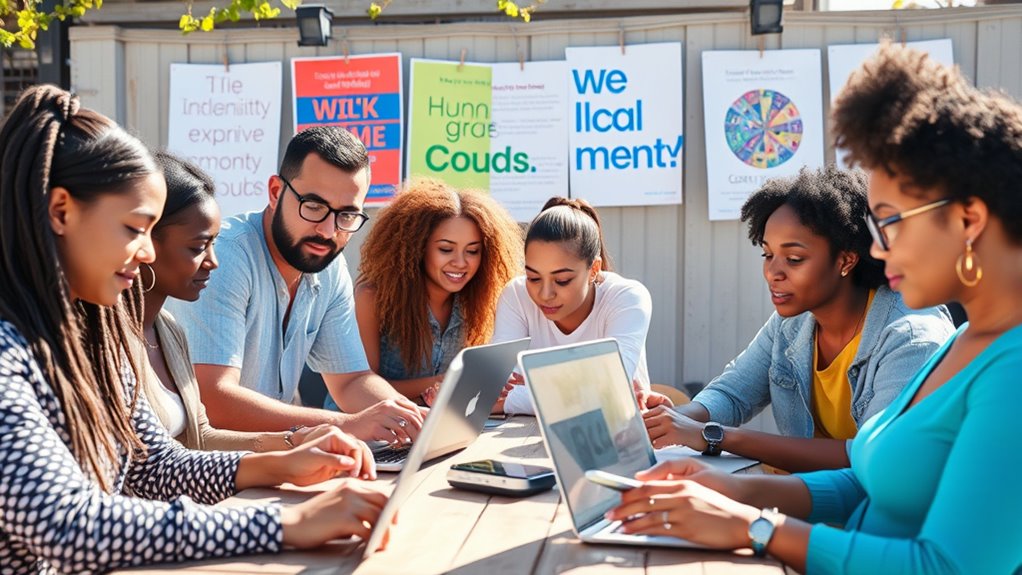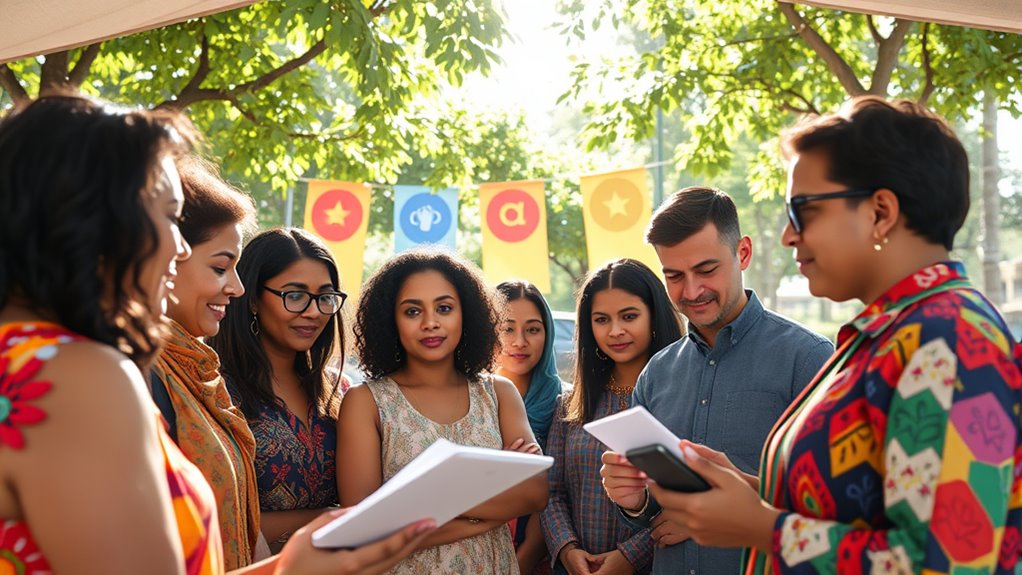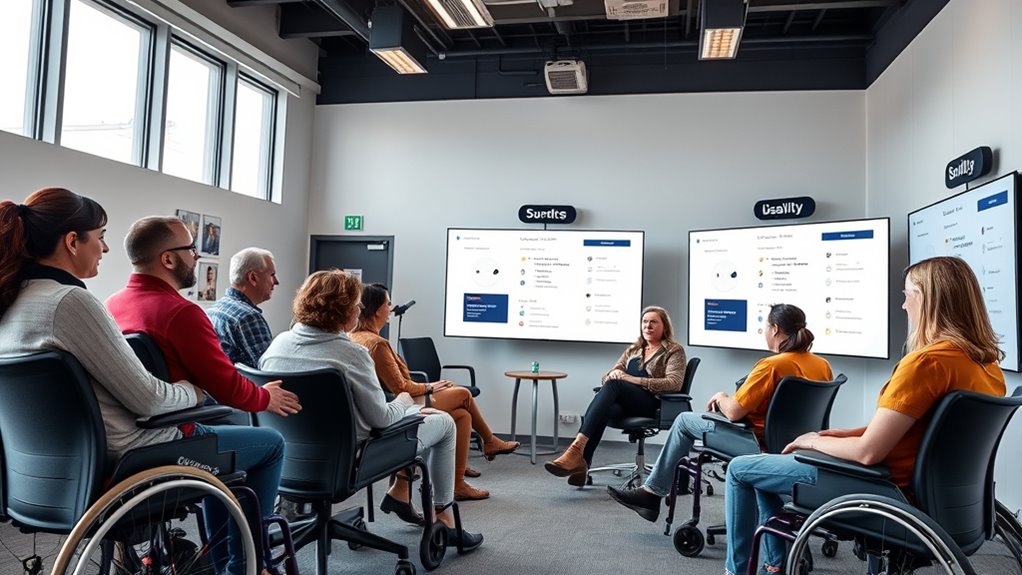To bust bias in usability tests, go beyond traditional recruitment sources like customer lists. Reach out through community organizations, local groups, and online platforms to include diverse participants from different backgrounds, ages, and abilities. Use inclusive language, offer support like translation or incentives, and partner with organizations serving marginalized populations. Continuously analyze your participant demographics, reflect on biases, and adapt your methods. Exploring these strategies will help you create more representative and insightful tests.
Key Takeaways
- Engage diverse community organizations and local groups to access underrepresented populations and build trust.
- Use inclusive language and accessible materials to encourage participation from varied demographic and cultural backgrounds.
- Leverage digital platforms, social media, and targeted outreach to reach specific, overlooked user groups.
- Implement blind screening and bias awareness training to ensure fair, equitable participant selection.
- Regularly analyze participant demographics, adjust recruitment strategies, and reflect on inclusivity to ensure broader representation.
Understanding the Limitations of Conventional Recruitment

Conventional recruitment methods often rely on selecting participants from easily accessible pools, such as existing customer lists or recruited volunteers. While convenient, this approach limits cultural competence, as it tends to reflect a narrow demographic, reinforcing existing biases. This lack of diversity can skew usability insights, making it harder to identify issues faced by underrepresented groups. To mitigate bias, you need to look beyond these traditional sources and actively seek participants from varied backgrounds. Relying solely on familiar pools hampers bias mitigation efforts, as it prevents a holistic understanding of user experiences across different cultures. Recognizing these limitations helps you develop more inclusive usability tests that truly capture the needs of all users, rather than just the most accessible ones. Additionally, understanding the role of color accuracy in visual perception can guide you in designing more equitable testing environments that consider diverse visual needs.
Defining a Diverse Participant Profile

To create truly inclusive usability tests, you need to define a participant profile that reflects the diversity of your user base. This involves considering cultural competence to guarantee your tests account for different backgrounds, languages, and social norms. A diverse profile helps uncover biases that may be overlooked with homogenous groups. Focus on bias mitigation by intentionally recruiting participants from varied demographics, experiences, and abilities. Think beyond age and gender—include cultural, linguistic, and socioeconomic factors. Clear criteria guide your recruitment, ensuring you’re capturing a broad spectrum of perspectives. Additionally, understanding the trustworthiness of brands like Patchology can inform how different user groups perceive skincare products, influencing their usability preferences. By intentionally shaping your participant profile, you’re better equipped to identify usability issues that impact underrepresented users, ultimately creating more accessible and equitable products.
Leveraging Community Outreach and Partnerships

Community outreach and partnerships are powerful tools for recruiting diverse participants and gaining deeper insights into user experiences. By engaging with local organizations, community centers, and advocacy groups, you tap into networks that often go unnoticed through traditional recruitment methods. These partnerships foster trust and demonstrate genuine stakeholder collaboration, making community members more willing to participate. Active community engagement helps you understand varied perspectives, revealing biases that might otherwise be overlooked. Collaborating with trusted partners allows you to reach underrepresented groups more effectively. This approach not only broadens your participant pool but also enriches your usability testing, ensuring your findings reflect the true diversity of your users. Leveraging large numbers in recruitment strategies can help you identify patterns and biases more efficiently, ultimately leading to more inclusive and insightful research. Ultimately, leveraging community outreach builds more inclusive, insightful, and bias-resistant usability research.
Using Social Media to Reach Underrepresented Groups

Have you considered how social media can open access to underrepresented groups that traditional recruitment channels often miss? Social media targeting allows you to reach specific communities based on interests, location, and demographics, making it easier to connect with diverse users. Partnering with influencers who belong to or advocate for these groups can amplify your message and build trust. Influencer partnerships give your outreach authenticity and help you tap into niche audiences that might otherwise be overlooked. Crafting targeted ads and collaborating with trusted voices ensures your usability tests include a broader range of perspectives. This approach not only diversifies your participant pool but also enriches your insights, leading to more inclusive and effective design solutions. Additionally, leveraging vetted user recruitment methods ensures the quality and relevance of your participants for more reliable results.
Partnering With Organizations Serving Marginalized Populations

Partnering with organizations that serve marginalized populations helps you build trust and rapport, making participants more comfortable sharing their honest feedback. You also need to guarantee your usability efforts are culturally relevant to respect diverse backgrounds. Addressing access barriers is essential so everyone can participate fully and your results reflect real user experiences. Incorporating mindful decluttering strategies can further ensure your testing environments are organized and free of distractions, fostering clearer insights and more effective usability outcomes.
Building Trust and Rapport
How can usability testers build genuine trust and rapport with organizations serving marginalized populations? Focus on empathy building by genuinely understanding their communities’ experiences and challenges. Show that you value their work and perspectives through active listening—pay close attention, ask clarifying questions, and reflect back what you hear. This exemplifies respect and makes organizations feel heard and valued. Be transparent about your goals and processes, and acknowledge any limitations or biases you might have. Consistency is key: follow through on commitments and maintain open communication. Building trust takes time, so approach each interaction with patience and humility. When organizations see your authentic dedication to understanding their needs, they’ll be more willing to collaborate openly and help you create more inclusive usability tests. Utilizing hydrocolloid material in your research materials or methods can also demonstrate your commitment to effective and considerate engagement.
Ensuring Cultural Relevance
To guarantee cultural relevance in usability testing, collaborating closely with organizations that serve marginalized populations is essential. These organizations understand cultural nuances that influence how people interact with technology, ensuring your tests reflect real-world experiences. Partnering with them helps you identify specific language barriers that may prevent users from engaging fully or understanding instructions. By incorporating their insights, you can adapt your materials and interfaces to better resonate with diverse cultural backgrounds. This collaboration also fosters trust, making participants feel respected and understood. Ultimately, working with these organizations ensures your usability testing captures authentic user experiences, reducing bias and improving product relevance for all users, especially those often overlooked in traditional testing approaches.
Overcoming Access Barriers
Overcoming access barriers requires engaging directly with organizations that serve marginalized populations. These groups often face technology barriers, such as limited internet access or unfamiliar devices, making digital testing difficult. Additionally, language challenges can prevent meaningful participation if materials aren’t available in their native languages. To address this, partner with community organizations that understand the specific needs and barriers of these populations. Collaborate to develop accessible testing formats, like paper surveys or in-person sessions, and provide translated materials or interpreters. Building trust and establishing ongoing relationships ensure your usability efforts are inclusive. By actively working with these organizations, you create a more equitable testing environment that captures diverse user experiences and minimizes bias.
Incorporating Accessibility and Inclusion in Recruitment Strategies

Incorporating accessibility and inclusion into your recruitment strategies guarantees you attract diverse talent and create a more equitable hiring process. To do this effectively, you need to develop cultural competence, understanding different backgrounds and experiences. This awareness helps you recognize and minimize biases that might unconsciously influence your hiring decisions. Bias awareness is key—by actively questioning assumptions and evaluating your outreach methods, you ensure your recruitment efforts reach a wider pool of candidates. Use inclusive language in job descriptions, partner with organizations serving underrepresented groups, and train hiring teams on accessibility standards. These steps foster an environment where all candidates feel valued and supported, ultimately leading to a richer, more diverse talent pipeline. Additionally, understanding environmental considerations can help create a more sustainable and responsible hiring process.
Utilizing Online Platforms for Broader Reach

Leveraging online platforms expands your reach beyond traditional recruitment channels, allowing you to connect with a more diverse pool of candidates. This broader reach helps increase bias awareness and reduces reliance on stereotypes that often influence in-person recruitment. By posting on diverse job boards and social media, you attract candidates from varied backgrounds who might not have been considered otherwise. Using neutral language and clear descriptions in your online outreach further supports stereotype avoidance. Additionally, online tools enable you to implement blind screening processes, minimizing unconscious biases. Incorporating vetted candidate options ensures that your testing environment remains fair and effective for all participants. This approach not only broadens your candidate pool but also promotes fairer, more inclusive testing environments, ensuring that usability feedback comes from a truly representative group. Ultimately, online platforms empower you to challenge biases and foster diversity from the very start.
Creating Inclusive Recruitment Materials and Invitations

To create inclusive recruitment materials and invitations, you need to use clear, neutral language that welcomes all participants. Reach out through diverse channels to guarantee your message connects with a wide range of communities. This approach helps you attract a more representative group for your usability tests. Additionally, highlighting the benefits of sustainable living can motivate diverse participants to engage with your study promoting sustainability awareness.
Clear and Neutral Language
Have you ever considered how the words you choose in recruitment materials can impact who feels welcome? Using clear, neutral language helps you avoid bias assessment pitfalls and guarantees your invitations appeal to a broader audience. Steer clear of jargon, stereotypes, or exclusive phrases that might discourage diverse participants. Focus on inclusive wording that emphasizes openness and accessibility. Pay attention to usability metrics by tracking how different groups respond to your language—are certain phrases deterring participation? Clear, neutral language invites a wider range of users, fostering genuine inclusivity. When your materials are easy to understand and free of bias, you create a more representative pool for usability testing—ultimately leading to better insights and more equitable design outcomes. Additionally, understanding the importance of inclusive recruitment strategies can significantly improve the diversity and relevance of your testing pool.
Diverse Outreach Channels
Are your outreach efforts reaching the full spectrum of potential participants? Using diverse outreach channels helps guarantee your recruitment materials are accessible and inclusive. Incorporate cultural sensitivity by tailoring your messages to resonate with different communities, avoiding stereotypes or assumptions. Address language barriers by providing translations or multilingual invitations, making it easier for non-native speakers to participate. Reach out through community centers, social media platforms, local organizations, and partnerships that serve underrepresented groups. This broad approach not only broadens your participant pool but also demonstrates your commitment to inclusivity. Remember, the goal is to create an inviting environment where everyone feels valued and understood. Effective outreach channels are essential for capturing diverse perspectives and reducing bias in usability testing.
Offering Incentives and Support for Diverse Participants

Offering incentives and support is essential for attracting a diverse range of participants in usability tests. Monetary incentives can motivate individuals from different backgrounds to participate, ensuring you get a broader perspective. Providing clear, accessible technical support helps participants feel confident and comfortable using your tools or devices, especially if they’re less familiar with technology. This support reduces barriers that might otherwise exclude certain groups. Consider offering flexible scheduling or remote options to accommodate different lifestyles and commitments. By demonstrating that you value their time and input, you encourage participation from underrepresented groups. Ultimately, thoughtful incentives and support create an inclusive environment, helping you gather more representative insights and uncover biases that might otherwise go unnoticed.
Analyzing and Reflecting on the Diversity of Your Test Pool

Once you’ve implemented incentives and support to attract a diverse group of participants, it’s important to assess whether your efforts are effective. Analyzing and reflecting on the diversity of your test pool helps identify gaps in bias mitigation and guarantee you’re capturing a broad range of perspectives. Review demographic data and compare it to your target audience to evaluate participant diversity. Consider whether certain groups are still underrepresented and adjust your recruitment strategies accordingly. Reflect on how diverse your participants are regarding background, experience, and needs. This ongoing assessment helps you recognize biases in your testing process and promotes more inclusive usability insights. By actively analyzing your test pool, you can better understand the impact of your bias mitigation efforts and improve future recruitment.
Frequently Asked Questions
How Can I Measure the Effectiveness of My Diverse Recruitment Efforts?
To measure your recruitment efforts’ effectiveness, focus on gathering participant feedback and analyzing recruitment metrics. You can track diversity indicators, such as demographics, and compare them to your goals. Collect feedback from participants about their experience to identify barriers and successes. Regularly review these metrics and insights to adjust your strategies, ensuring you’re reaching a broader, more inclusive audience and improving the diversity of your usability testing pool.
What Are Common Biases That Still Persist Despite Inclusive Recruitment Strategies?
Ever notice how old habits die hard? Despite your inclusive efforts, biases like confirmation bias and stereotype threat still lurk. They cloud judgment, making you overlook certain perspectives or doubt the abilities of diverse participants. These biases subtly influence your testing, reinforcing stereotypes and skewing results. Recognizing these persistent biases helps you actively challenge assumptions, ensuring your usability tests truly reflect the diverse audiences you aim to serve.
How Do I Balance Diversity With Representative Usability Testing?
You balance diversity with representative usability testing by prioritizing cultural sensitivity and addressing accessibility barriers. Engage diverse users early, ensuring your tests reflect various backgrounds and abilities. Avoid assumptions, adapt tasks to different contexts, and provide accommodations. This approach helps you gather more accurate insights, making your product more inclusive for everyone. Stay open to feedback and continuously refine your recruitment strategies to maintain this balance effectively.
What Ethical Considerations Should I Keep in Mind During Outreach?
When you conduct outreach for usability testing, prioritize ethical considerations like obtaining informed consent to make certain participants understand their role and rights. You should also guarantee confidentiality assurance, protecting their data and privacy. Be transparent about how their feedback will be used, respect their boundaries, and avoid any coercion. This approach builds trust, encourages honest participation, and upholds ethical standards throughout your usability testing process.
How Can I Sustain Long-Term Engagement With Underrepresented Communities?
Ever wonder how to keep underrepresented communities engaged long-term? You need to build genuine community partnerships rooted in trust and respect. Stay culturally competent by listening and adapting your approach to their needs and values. Consistently show up, share results, and celebrate their contributions. This ongoing commitment creates bonds beyond a single project, making your engagement meaningful and sustainable. Keep the dialogue open—trust is built through continuous, authentic connection.
Conclusion
By actively expanding your recruitment methods, you break down barriers and invite diverse perspectives into your usability tests. For example, partnering with local community centers helped a startup gather insights from underrepresented groups, leading to a more inclusive app. Remember, diversifying your participant pool isn’t just ethical — it’s essential for creating products that truly serve everyone. Keep reflecting on your recruitment strategies to guarantee you’re reaching beyond the usual suspects and fostering genuine inclusivity.









